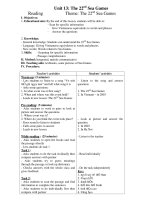lesson plan nguyen thi thuy lesson plan unit 13 the 22nd sea games lesson 4 writing 1 class description 42 students from class 12d6 xuan dinh high school tu liem hanoi 2 time 45 minutes 3 objective
Bạn đang xem bản rút gọn của tài liệu. Xem và tải ngay bản đầy đủ của tài liệu tại đây (102.5 KB, 4 trang )
<span class='text_page_counter'>(1)</span><div class='page_container' data-page=1>
Nguyen Thi Thuy
<b>LESSON PLAN</b>
<b>Unit 13: The 22</b>
<b>nd</b><b><sub> SEA Games</sub></b>
<b>Lesson 4: Writing</b>
<b>1. Class description: </b>42 students from class 12D6, Xuan Dinh high school, Tu Liem,
Hanoi.
<b>2. Time: </b>45 minutes
<b>3. Objective:</b>
After the lesson, the students are able to use some useful language to describe a football
match such as the actions of the players, the name of players on the field, and the emotion
after watching the match, etc.
<b>4. Assumed knowledge:</b>
- The students have already learnt about the verb tenses, the part of speech like verbs,
adjectives, nouns, and linking words and sentences.
<b>5. anticipated problems:</b>
- Some students do not want to take part in the lesson and make noise
- Some can not answer all the questions and know how to write effectively.
- There might be lack of time, so T can let S go home to write and check later.
<b>6. Teaching aids:</b>
Textbooks, pictures
<b>7.</b>
Procedure:
<b>Teacher’s activities</b> <b>Students’ activities</b>
<b>7.1.</b> <b>warm – up</b>
- asks the students some questions:
<i>Do like play football?</i>
<i>Do you often play football?</i>
<i>In what occasions do you often play football?</i>
<i>Where do you often play football?</i>
<i>What were the results of the matches?</i>
Listen to the teacher and answer T’s questions
</div>
<span class='text_page_counter'>(2)</span><div class='page_container' data-page=2>
Nguyen Thi Thuy
<i>How many parts are there in a match? How long</i>
<i>are they?</i>
<i>How many players are there in the field? Can you</i>
<i>name their positions in the field? Are there a lot of</i>
<i>people in the field?</i>
<i>Do the players wear the same clothes? What is</i>
<i>often on their clothes?</i>
<i><b>today we will learn how to describe a football</b></i>
<i><b>match</b></i>
<b>7.2.</b> <b>Pre – writing: Brainstorming</b>
- Asks the students to read 10 questions in the
textbook.
- Helps the students to deal with new words in
the questions if necessary
- Asks the students to answer the questions to
find out the useful language.
<i>How can we answer all these questions?</i>
1. How did each team play in the first part?
<i>Which kinds of information will we use to answer</i>
<i>this question<b>?</b></i>
2. What was the result?
3. When and where did the match take place?
<i>“When” and “where” are the questions for what? </i>
4. Why was the football match was held?
<i>Which kinds of information will we use to answer</i>
<i>this question<b>?</b></i>
Read 10 questions in the books carefully
Ask the T new words
Answer the questions under the direction of the T
<b>Expected answer:</b>
<i>Adjective: very well, very bad, excitedly, etc. </i>
<i>There need a noun: the host won, the guest won</i>
<i>or draw.</i>
- <i>“when” is the questions for time and</i>
<i>“where” is the questions for place</i>
- <i>The match took place in the stadium or the</i>
<i>field in summer or winter, on day, month,</i>
<i>year, etc.</i>
<i>- the verb</i>
<i>To practice playing football</i>
<i>To enhance the health</i>
</div>
<span class='text_page_counter'>(3)</span><div class='page_container' data-page=3>
Nguyen Thi Thuy
5. What did you think about the game?
6. What was the weather like on that day?
7. What teams took part in the match?
<b>8.</b> What was the spectators’ attitude?
<b>9.</b> Which team played better?
<b>10.</b> Who scored a goal?
<b>7.3. while – writing</b>
- asks the student some questions:
<i>How many parts are there in a composition?</i>
<i>What is their function?</i>
- asks the students to work in pairs and what
questions will be in each part of the
composition
- asks the students to work in pairs: One asks and
one answer about each questions in each part
<i>To build up the solidarity and friendship</i>
<i>To celebrate teacher’s day or new school year,</i>
<i>etc.</i>
<i>- The adjective or a sentence: boring, exciting,</i>
<i>etc. </i>
<i>- it was sunny, beautiful, rainy or wind</i>
<i>- the host and the guest or the home team and the</i>
<i>opponent </i>
<i>- the adjective: exciting, jump up and cheers,</i>
<i>shout, laugh and applause, etc</i>
<i>- the host or the guest</i>
<i>- the attacker or the others</i>
<i>Three parts: introductions, body and conclusion</i>
<i>Introduction part is to introduce the topic and</i>
<i>describe generally.</i>
<i>The body is the details of the topic like the</i>
<i>duration, the main issues or the activities </i>
<i>The conclusion is to summarize what has just</i>
<i>discussed</i>
<i><b>- expected answers:</b></i>
<i>Introduction: 4-7-3</i>
<i>Details in the match: 6-1-8-9-10</i>
<i>Conclusion: 2-5</i>
- work in pairs and do the task
</div>
<span class='text_page_counter'>(4)</span><div class='page_container' data-page=4>
Nguyen Thi Thuy
- asks the students to write down the sentences
into the notebooks
- asks the students how to arrange them into the
composition by using linking words
- asks them to work in groups and write the
compositions
- helps the students if necessary.
- if there isn’t enough time, T can ask the students
to write it at home and check it in the next lesson.
<b>7.3. Post – writing</b>
- checks the students’ writing: grammar or
spelling, expression mistakes.
- gives the comment to make them better in next
time
<b>8. Evaluation</b>
- write down the sentences into the notebook
- using after, firstly, secondly, etc
<i>Listen to the T</i>
</div>
<!--links-->









